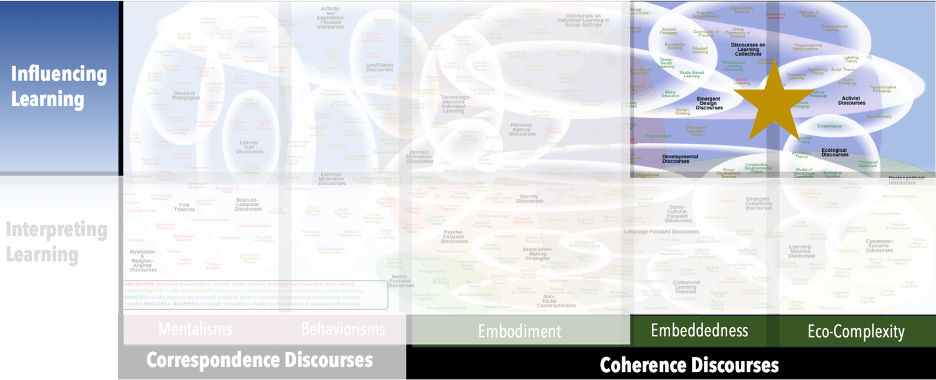AKA
UDI
UDL
UID
Universal Design for Instruction
Universal Instructional Design
Focus
Structuring educational contexts around ability rather than disabilityPrincipal Metaphors
- Knowledge is … ability
- Knowing is … appropriate action
- Learner is … an able agent-in-context (systemic)
- Learning is … developing ability
- Teaching is … designing
Originated
1990sSynopsis
Universal Design for Learning is founded on the principle of Universal Design ...- Universal Design (Ronald Mace, 1990s) – the principle (and associated ethical imperative) of creating products and environments that are comfortably usable for people of all ages, physical abilities, and cognitive abilities
- Discriminatory Design (Exclusionary Design) (Ruha Benjamin, 2010s) – qualities engineered into spaces, systems, and artifacts that assert or maintain privilege for some and disadvantage for other. Prominently critiqued school-based examples include unrepresentative reading materials and standard-sized desks, among many, many other aspects of formal education. Specific examples of Discriminatory Design include:
- Built Pedagogy (Torin Monahan, 2000s) – the realization that physical educational structures are informed by, reflective of, and created in service of specific educational philosophies. For example, Standardized Education is associated with long hallways of equal-sized rectangular classrooms filled with equal-spaced, standard-sized desks.
- Design for the Average – the principle and practice behind the creation of products and environments based on average human dimensions
- Handism – a bias against left-handed people. Although no longer the explicit site of oppression that it was until well into the 20th century, it continues to be manifest pervasively in the designs of tools and constructions that render some tasks difficult, uncomfortable, and sometimes hazardous for left-handed people.
- Hostile Architecture (Unpleasant Design) (2000s, Nils Norman) – aspects of the built environment that are designed to shape behavior by, for example, guiding or restricting actions
- Accessibility Theory (E. Tory Higgins, 1980s) – a diversely interpreted perspective that centers around the necessary considerations to ensure all affected populations have access to the resource or service under consideration. Most often, Accessibility Theory is associate with matters of language-based information (e.g., popular publications, internet resources, formal examinations), but variations of the theory have been applied much more broadly.
- Accessible Education (2020s) – an increasing prominent catchphrase that is used to refer to strategies and obligations to adapt educational structures and offerings in ways that are accommodated to the specific needs of individual learners. (Contrast: Special Education in Medical Model of (Dis)Ability, and Diversity Education and Inclusive Education in Activist Discourses.)
- Design for Adjustable Range – the principle and practice behind the creation of products that can be adjusted to comfortably suit the physical characteristics and/or mental conditions of as many people as possible
- Principled Innovation® (Mary Lou Fulton Teachers College, Arizona State University) – a copyrighted approach to Universal Design that emphasizes attending to moral, civic, intellectual, and performance considerations
- Reasonable Accommodation (United Nations, 2000s) – according to the UN’s the Convention on the Rights of Persons with Disabilities, “necessary and appropriate modification and adjustments not imposing a disproportionate or undue burden, where needed in a particular case, to ensure to persons with disabilities the enjoyment or exercise on an equal basis with others of all human rights and fundamental freedoms”
- Transgenerational Design (James Pirkl, 1980s) – consistent with Learning Design, and highly resonant with Universal Design for Learning, the discourse focuses on products and contexts that can accommodate the widest possible range of consumers, especially across age groups
Commentary
Universal Design for Learning might be identified as a counter-discourse to the very popular Differentiated Instruction. Both are concerned with addressing differences among learners. They separate radically around notions of difference. Aligning with Ecological Discourses and Emergent Complexity Discourses, Universal Design for Learning approaches difference as a systemic phenomenon – thus regarding it as a source of human potential while highlighting that “disability” is not a quality of the agent, but the agent in the situation. (Within Differentiated Instruction, learner difference is typically framed in terms of individuals’ traits.) Despite this dramatic contrast in conceptual framing, the advice to educators is often surprisingly similar.Authors and/or Prominent Influences
David Rose; Center for Applied Special Technology (CAST)Status as a Theory of Learning
Universal Design for Learning in not a theory of learning – although, among contemporary educational discourses – it is unusual in invoking principles of learning that are associated with Eco-Complexity Discourses.Status as a Theory of Teaching
Universal Design for Learning is a perspective on teaching.Status as a Scientific Theory
Some modest empirical evidence has been generated in support of the principles of Universal Design for Learning. In terms of our working definition of “scientific,” the strength of the discourse lies largely in its critical attentiveness to its own assumptions about learning, learners, ability, and associated constructs.Subdiscourses:
- Accessibility Theory
- Accessible Education
- Built Pedagogy
- Design for Adjustable Range
- Design for the Average
- Discriminatory Design (Exclusionary Design)
- Handism
- Hostile Architecture (Unpleasant Design)
- Principled Innovation®
- Reasonable Accommodation
- Transgenerational Design
- Universal Design
Map Location

Please cite this article as:
Davis, B., & Francis, K. (2023). “Universal Design for Learning” in Discourses on Learning in Education. https://learningdiscourses.com.
⇦ Back to Map
⇦ Back to List
